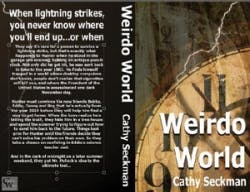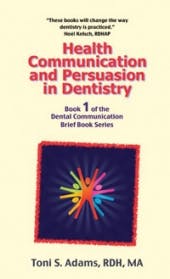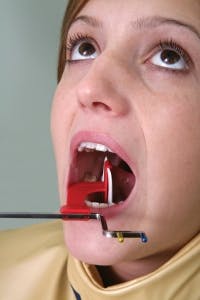Three RDH authors publish books
by Cathleen Terhune Alty, RDH
“Some writers are made by the sheer dint of desire,” writes Marie Arana, author and writer-at-large for the Washington Post. “Even so, aspiration is never quite enough. There is the sense that you have no choice — that the gift comes with an overwhelming need. You don’t just stumble into this line of business.”
Writers have to write. It’s beyond a compulsion — there’s always another project in our head longing to be drawn out onto the page and then brought into the mind of a reader. We don’t have to win awards or have millions of copies sold (although both are wonderful!), but we do need readers. The writer creates and presents the gift. It’s something learned that must be shared, an experience that must be retold, a fantasy world that must be brought to life. The receiver reads, responds, and retains a small piece of the writer’s thoughts. Why, it’s practically magic!
Some very talented writers are also hygienists and call RDH magazine home. We are proud to highlight three RDH writers who have recently published books.
Cathy Seckman, RDH
From back of the book to front page news: www.cathyseckman.com.
“I wanted to write all my life, but was never brave enough to tell anyone,” says Cathy Seckman, a long-time, prolific feature writer for RDH magazine.
Following in her sister’s footsteps by majoring in dental hygiene instead of creative writing at West Liberty State College, she found a certain satisfaction in dental hygiene practice. However, she managed to fit her love of writing into her dental hygiene career and make them perfectly harmonize.
Seckman dipped a toe in the writing waters in the early 1980s, but soon jumped in headfirst.“I got a manual typewriter and started trying to write romance novels. I went to a few local writing conferences, read writing magazines and books, and learned a few things. Starting in 1985, I published a few articles in small magazines. In 1987, I wrote a letter to the editor of the county newspaper, complaining because I couldn’t find their office during my lunch hour to place an ad. The editor used it in his next column as an example of a good letter to the editor. I gathered up all my nerve, called him, and asked for a job. ‘Well, no,’ he said, ‘we hire people with journalism degrees. But you can do some freelance articles for me.’ I did about a dozen of those, and then my (smaller) hometown paper’s editor called and offered me an interview. I got that job, turned my back on dentistry, and was a lifestyles editor, wire editor, and feature writer for seven years.”
Office politics eventually drove her from the newsroom, and she decided to return to dentistry and magazine writing. This time she was successful with both careers, working hygiene part time and writing for several different magazines. She soon was writing regularly for RDH magazine as well as several different motorcycle magazines, a couple of camping magazines, and a trade journal for the small-engine industry.
Encouragement for her budding writing career came from many sources. An enthusiastic member of her local Writers Anonymous group, Seckman credits her fellow members for their support. Through contacts at her writers group, Seckman discovered True Experience magazine.
“In 2009, I sold my first piece of fiction to True Experience magazine. I’ve sold about a dozen stories to them — there used to be five of the magazines, but hard times hit and there are only two left.” Other encouragers include Editor Mark Hartley at RDH magazine, “who has always been enthusiastic about my writing, and ready to listen to any of my ideas,” and Michael Bracken. “He’s a novelist from Texas, and the acknowledged king of short stories. He writes a good number of the stories that appear in True magazines. I took a class from him on writing confessions, and shortly thereafter sold my first True.”
As another facet to her writing career, Seckman is an indexer, writing the index you find in the backs of nonfiction books. She mostly works on college-level textbooks, including indexing the books of our other two book authors!
“Right now I’m working on Toni’s [Adams] ‘Brief Book Series.’ I also did Dianne’s [Watterson] ‘Manage Your Practice Well’ book, and several of Shirley Gutkowski’s and Amy Nieves Petrillo’s ‘Purple Guide’ books.”
Seckman’s first novel is titled “Weirdo World.” She describes it as “a young adult fantasy aimed at teenage boys, but it’s a book everyone can enjoy.” The publisher is Cool Well Press, www.coolwellpress.com, a mainstream commercial eBook and print book company. It is available for purchase at amazon.com.
The idea for the book came from an unlikely character.
“I started out idly thinking about the differences between the Tarzan movies I knew as a child, and the Disney Tarzan. That became a contrasting story idea that could only be handled by time travel.”
The story in her mind grew over time, in ways even Seckman doesn’t quite understand. “I don’t know why the protagonist is a 12-year-old boy, but he is. Fiction writers always say characters take on a life of their own, and dictate their own story, and that’s pretty much what Hunter did. He told the story for me.”
Hunter’s story was quite a consuming daydream.
“I kept the story as a whole in my head, and thought about it at odd times: while I was washing my hair, or doing laundry, or driving to work, or trying to fall asleep at night. Maybe Hunter could live in a tree house, like Swiss Family Robinson. But how would he pee? take a bath? eat? When those things were worked out, I could proceed with the story.”
The book didn’t always follow her assumptions.
“I expected Tarzan to be an important part of the book. It opens with a Tarzan yell. But as the story developed, it became more of a boys’ adventure story. They go swimming, play baseball, hang out in the tree house, punch each other a lot. I was picturing myself as a 12-year-old, knowing the things I knew then, and contrasting them to the things a 12-year-old knows now, and that became the most important focus of the book.
“It took a couple of years because I stopped and started a few times. I always used to feel guilty working on fiction, because I couldn’t get anyone to pay me for it, but since I started selling True stories, I don’t feel so guilty anymore.”
However, when the demands of reality call — and they call everyone — Seckman puts the fiction story aside for a less busy time.
“Time is a big challenge. When I started indexing, I promised myself I’d never take a personal day from work to meet an indexing deadline, and so far I haven’t, but I get up at 4 a.m. pretty regularly, and work lots of weekends. Right now I’m supposed to be finishing an index for a freshman composition text, but this was way too tempting.”
Seckman is already wondering where she will find the time to write the next novel.
“My husband is a pretty busy guy himself, and I’m always careful to put him first. If we have plans and I have an index due, we go ahead with the plans and I get up early the next morning. It’ll be more difficult now, as I try to carve out time for a second novel. Everyone thinks I only work 13 hours a week, because that’s my day job. But in reality, I probably work 50 to 60 hours a week.”
Now she will need to add a few more hours to help market her book.
“The hard work doesn’t stop when you write ‘The End,’” says Seckman. “Cool Well Publishing will be targeting Internet sources of young readers, but publicizing the book will pretty much be up to me. I’ve tapped all my resources in dentistry; I’ve announced it on my True writers’ email list and my indexers’ email list. I’ve told everyone I know. I’m going to call the two newspapers I used to work for and ask them for interviews. If the book does make it to bookshelves (just a possibility right now), I’ll call the local Barnes & Noble and try to arrange a book signing. I may also try to have a book signing at the local coffee shop.
“Hygiene has been very good to me,” she says, “and there’s a lot of satisfaction in it. I managed to fit my love of writing into it, thanks to Mark Hartley, and I discovered that pediatrics is a great specialty. I get to do a little speaking once in a while, and I enjoy that. I don’t regret my hygiene career at all — maybe my path was always supposed to turn out this way. I job-hopped a lot, but settled into my current job eight years ago. I’ll retire from this one, I’m sure. I work 13 hours a week in a pediatric practice for Jay Reznik, DMD, MS, in Monaca, Penn. My boss is one of those guys who says ‘two more years’ whenever anyone asks him about retirement. But I wouldn’t be surprised if he works another 10 years, and if he does, I’ll stay — I like it that much.”
Toni S. Adams, RDH, MA
Everyone has talents that they may not know they have: www.toniadams.com.
Toni Adams has had many careers: Cataloguing at the University of Denver library, a bookkeeper at anadvertising agency, and a “stewardess” for Pan American Airways in the 1960s, working R&R flights in and out of Vietnam. After she graduated from Foothill College in Los Altos Hills, Calif., in 1973 with her dental hygiene credentials, she worked at several different dental practices for the next 26 years in and around San Jose.
“In that time, I worked in GP and periodontal offices, as well as in a large group practice and a nonprofit clinic. As lead RDH in the large group practice, I wrote the dental hygiene office manual and many other documents.”
Adams says that writing seemed to come naturally, and this was probably where her interest in writing began. When a hand disability sidelined Adams from her dental hygiene career in 1999, she went back to school and earned a baccalaureate degree from San Jose State University, and then a master’s degree at California State University in Sacramento in communication studies. With a focus on oral and written communication as well as critical thinking, Adams spent much of her college experience writing.
“I learned so much while working on my BA and MA that I wish I had known while I was practicing, so the next best thing was to share that information with other dental professionals.”
Guidance from professors and a fascination with nonverbal communication lead to her first magazine article submission.
“This was before I depended too much on electronic communication, so I called the magazine to ask whether or not I could submit my article,” she said. “The person who answered said, ‘Oh, here’s the editor,’ and she put Mark Hartley on the phone. I was amazed to be speaking with the editor on the spot! Mark was so encouraging and asked me to email the article, which I did. It appeared in the September 2002 edition of RDH, and that was the first time I was “published.” It was such a thrill; I couldn’t believe it. I found that I loved to write and subsequently wrote other articles that appeared in RDH and other publications. In the past few years I have also done some editing,” she said.
A book project soon blossomed in her thoughts as she considered her hygiene career with her communications studies.
“I found many fascinating topics in the communication studies field, so I read about and studied them even outside of class requirements. I couldn’t get enough of them. I wrote a communication handbook for dental hygienists for my master’s project. That developed into what I am in the process of publishing now, ‘The Dental Communication Brief Book Series.’”
Although the series originally started as a single book, Adams reconsidered and decided instead to self-publish her writings as a series of short books.
“People seem to appreciate that the books can be read in one or two sittings, and the price for each is reasonable, too. My seven-book series includes volumes on health communication and persuasion, intercultural communication, verbal communication, nonverbal communication, listening, patient interviewing, and patient education. These books are for everyone who works in the dental profession: dentists, dental hygienists, dental assistants, receptionists, office managers, office staff, company representatives, students, instructors, researchers, speakers, trainers, and anyone else interested in improving communication in the dental field.”
With so many other equally interesting careers in her past, how has writing a book series compared?
“It is time-consuming, but fascinating,” she said. “The biggest problem I have is deciding what to leave out. There is so much information out there. My process is choose a topic and narrow it down, find as much information as I can about it, read what I have found and take extensive notes, and organize the notes into an article or, in this case, a book.”
As with any project, support from family and friends often make the difference between success and failure. Adams singles out her biggest supporter: “My husband, John. If not for him, I would not have been able to do anything. He saw me through three college programs, AS, BA, and MA, and he still encourages me. He has read numerous copies of everything I have ever written and gives me invaluable feedback.” She also adds her “parents, sons, daughter-in-law, and brilliant granddaughter. They light up my life.”
Adams also credits her professional dental colleagues, especially the Listers on Amysrdhlist.
“They have been so helpful. Many of them read and reviewed various incarnations of the books and gave me important suggestions. Two who I especially admire, and who helped me, are the other subjects of this article: Cathy Seckman and Dianne Glasscoe Watterson. I might add that I “met” Dianne and Cathy, and most of these people, first through Amy’s List, and then in person at RDH Under One Roof events. Cathy Seckman has been an exceptional friend. She is a remarkably talented writer, so I feel so fortunate to have her advice. She is also indexing my books.”
Adams is generous with her time as well. As the recipient of the 2009 RDH Magazine Phillips Mentor of the Year Award, she mentors other dental hygienists.
It may feel to Adams like the learning curve never ends.
“I am self-publishing these books, and doing almost all of the work myself.”
She is getting ready to market her project as five of the books are in print and the other two will be printed shortly.
“Publishing is a whole other world with another vocabulary and all sorts of technical issues that I knew nothing about. I am still learning about ISBN numbers, bar codes, book cover design, book layout, printers, indexing, not to mention all the details of setting up a business. It is a challenge, but it is also exciting. Every time I think I have something handled, something else pops up. It is truly one of those two steps forward, one step back processes, but overall I have made progress.”
But like giving birth, you soon forget all the pain and focus on the end result.
“I can’t describe the feeling when I held the proof of the first book in my hands. It was so satisfying,” she says.
Dianne Glasscoe Watterson, RDH, BS, MBA
The Consummate Speaker, Consultant, Author, and Dental Hygienist: www.professionaldentalmgmt.com.
Dianne’s multifaceted dental career has prepared her to become one of dental hygiene’s most read and mostrecognized dental practice management consultants. A regular columnist for RDH magazine since 1998, her “Dear Dianne” column gives hygienists practical advice for dealing with some of our most difficult practice issues. She is well qualified to answer as her experiences in dentistry have run full circle from front office to back office and everything between.
“I started in dentistry in 1972 right out of high school working at the front desk in a very busy solo practice in Thomasville, N.C.,” she says. “There was no such thing as dental insurance, and I did everything at the front desk, including payroll, accounts payable, even the doctor’s quarterly taxes. Two years later, our chairside assistant left abruptly, and I was drafted into chairside assisting. So after four years in this practice, I decided to go to hygiene school.”
She graduated in 1978 with an associate’s degree in dental hygiene from Guilford Technical Community College. After practicing dental hygiene for several years, she became interested in practice consulting as her next career step.
“I was greatly impressed with a practice management consultant who was hired to help a practice where I worked many years ago,” she said. “Although I had managed a front office in a dental practice, I felt I needed some formal business education.”
Dianne returned to school and graduated in 1996 with a bachelor’s degree in human service management from Indiana Institute of Technology, narrowing the focus for the required internship to dental practice management. As part of her internship, Dianne was permitted to observe dental practice management“Linda allowed me to shadow her and attend her dental business conference as a part of my internship, along with four practices in a consulting capacity that agreed to have me as an intern. I furnished each practice with a detailed report of my observations and recommendations.”
Dianne continued her education and earned an MBA from Ashford University in 2009.
“I wanted to be a consultant, but doctors do not hire people they do not know. So building name recognition is very important.”
Her writing skills honed from university coursework, Dianne was encouraged to write for dental publications.
“My professional writing began in earnest when my mentor, Linda Miles, told me I needed to be published to build credibility in the speaking/consulting profession. I asked her what I should write about, and she replied that I should write about subjects about which I am passionate. She also told me not to get discouraged if I did not get published right away. So, in 1997, the fourth article I submitted to Dental Economics magazine was accepted for publication. That same year, I was also published in another journal called Dental Practice Reports (now defunct). My next article was published in RDH magazine in 1998, and I was hooked! I discovered how much I enjoyed creating articles, and I approached Mark Hartley about doing a column for RDH magazine. I wanted to write about real-life, in-the-trenches issues facing dental hygienists. The rest is history.”
Her published works gained popularity and helped her develop the name recognition she needed.
“From that, I was asked to speak to different dental groups, first local venues, then venues outside my locale and state. From speaking, I received consulting. Being published over and over in national journals has helped me develop name recognition, which has resulted in speaking invitations and consulting. Writing helped me develop lecture topics and seminars. My business is really three businesses that are closely intertwined — writing, speaking, and consulting.”
Dianne’s multifaceted dental practice experience compelled her to develop a book that would discuss the broad aspects of dental office management.
“My first book, ‘Manage Your Practice Well,’ was published in 2010. My desire was to write something that addressed some of the bedrock principles of good practice management, including staff, financial, and scheduling management. I also cover topics such as burnout, whether to lease or buy space, having a disaster plan, and assisted hygiene. This book was borne out of my business background and consulting experiences with hundreds of offices. The audience is dental business owners and office administrators.”
The book has done well and has earned three awards of excellence: the Grand Apex 2011 award, the Hermes International Platinum Award, and Communicators’ Gold Award 2011.
Desiring to bring all of her ideas about dental hygiene into a cohesive format, Dianne gathered the best articles she has written over the past five years to develop into her second book. She updated and edited them into her second book titled “The Consummate Dental Hygienist.”
“The first three chapters are about interpersonal relationships with patients, coworkers, and doctors. The next few chapters include information about clinical issues, practice management, and legal considerations. I finish with my thoughts on what it means to be a consummate dental hygienist. This book has been in my heart for a long time, and I’m so happy to see it come to fruition. Of course, the audience is dental hygienists.”
The book was released in October 2011 and is available on Amazon.com.
Watterson has a busy schedule with speaking and consulting, so finding time to work on book projects required dedicated time management.
“With the first book, the major challenge was setting aside time for the process. I wrote in airports, hotels, and late at night in my office. The second book was different, in that I delegated much of the development to Ted Anibal. He was responsible for categorizing the articles in cohesive chapters, and his eye for editing is the best in the business ([email protected]). He’s not happy if it’s not perfect. The articles for the book were already written, but he arranged the writing into a cohesive work. The biggest challenge — finding time — is the same as always. I’m not complaining. I’m happy to be busy,” she says. “I enjoy writing, so writing a book does not feel like work.” Besides her successful consulting business, Dianne also continues to practice clinical hygiene as a volunteer with Mission of Mercy.
Marketing her books also takes time, and is one of the few skills Dianne does not feel she has mastered. “Marketing is my weak point,” she says. “When Dr. Joe Blaes plugged my first book in Dental Economics, I received a flood of orders. However, I didn’t write the book with the thought of it being a profit center. I wrote the book to use as a marketing tool for my consulting business. I continue to receive orders through having my book mentioned in my bio line with my bimonthly column in Dental Economics. I also like to give complimentary copies of my books as door prizes in my meetings.”
Of course, Dianne has many encouragers when the going gets tough.
“My greatest encouragers are Linda Miles and my husband, David. My husband knows what a workaholic I am, so he has been very understanding. My friend and colleague, Bethany Valachi, was a great help in recommending a good publisher, since she had already published. Yvonne Pover, RDH, was the graphic artist for both books. She works clinically on a part-time basis and has a graphic arts business as well (www.pover.com) Ted Anibal was the force behind the second book. Last, but certainly not least, is Mark Hartley, my editor at RDH magazine. Mark gave me my ‘pulpit’ in RDH back in 1998, and I am eternally grateful for his confidence in me as a writer.”
Dianne’s only regret?
“That I didn’t publish sooner!” she says.
Cathleen Terhune Alty, RDH, is a frequent contributor who is based in King George, Va.
Reference
1. Arana M. “Writer at Large.” Rev. of River of Doubt and Destiny of the Republic by Candice Millard. The Washington Post, 18 Sept. 2011; 2.
Tips for hygienists who want to be published
From Dianne Glasscoe Watterson: Every writer has to learn to crawl, then walk, then run. The first three articles I submitted were not accepted, but the fourth one was. Once you get the editor’s attention and you find out what types of articles interest him or her, you will be on your way. A few of my early articles came back with copious “red ink” edits, and I learned valuable lessons on how to be more succinct with the written word. Also, some of my college writing courses helped me learn how to be clear without being overly verbose.
Some people think writing is drudgery, but I’ve never felt that way. You never know how you will feel about writing until you give it a try. For me, writing is a pleasurable experience. When I complete a writing project, I feel as if I’ve given birth. It’s my “baby,” because I created it. Don’t be afraid to make some mistakes, and learn through a process of continual improvement.
It is a good idea to shop around when deciding on a publisher, as the rates vary widely. I used a “print on demand” company, called Mira Digital Publishing (www.mirasmart.com). The last thing I wanted was a thousand books in my basement getting musty. I started with the initial run of 300 books and can easily order more as I need them.
It is also essential to retain a good editor, and smart idea to list a book with Amazon. I’ve received many orders through Amazon.
From Cathy Seckman: First, work on the craft. Read books on writing, join a writers’ group, take the free classes that are all over the Internet, attend local conferences (just Google writers’ conferences, your state). When you have some independent confirmation that your writing is good, talk to Mark Hartley!
From Toni Adams: Learn how to write from professionals. Take a writing course online or in person so you can get feedback from instructors. Read some books. Two of my favorite books about writing are the classic “Elements of Style” by Strunk and White and “Woe Is I” by Patricia O’Connor. Ask experienced colleagues to critique your efforts.
Keep going even when you get discouraged. With almost every writing project, I come to a point where I think, What am I doing? Who do I think I am? I can’t do this! Then, with a little more effort, and perhaps a little break from the writing, I have an epiphany and it all seems to come together. This is so common that my husband has taken to asking me, “Have you had your epiphany yet?” He stays away until I have.
Learn how to organize. I think the ability to organize is one of the most underappreciated writing skills. It is essential to creating a coherent piece. It is not a sexy topic, but knowledge of it is fundamental to developing writing skill. When I taught public speaking in graduate school we used to say, “Tell ’em what you’re gonna tell ’em, tell ’em, then tell ’em what you told ’em.” It’s basic. It’s boring. But it works and it applies to writing too.
Pay attention to the trite phrases: narrow your topic, keep it simple, less is more.
Read, read, read in the genre that interests you. Look for new topics and new approaches in your genre.
Past RDH Issues










